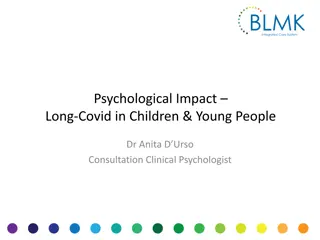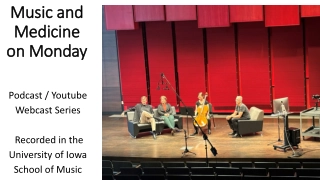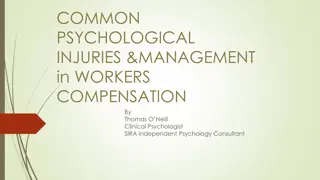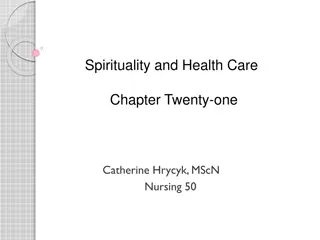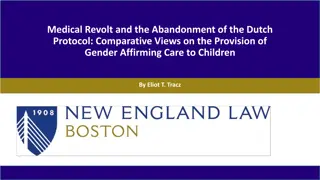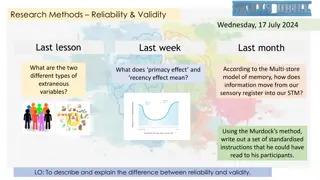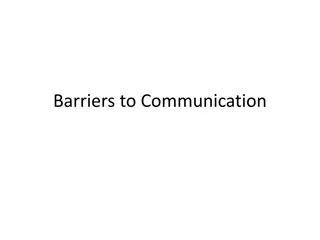Understanding the Impact of Tinnitus on Psychological Distress
Tinnitus is a common condition causing subjective and objective sensations of sound without external stimuli. It can lead to physical and psychological distress, affecting emotional well-being and coping abilities. The distress associated with tinnitus includes anxiety, depression, social disturbances, and sleep issues. Research suggests a strong link between severe tinnitus and excessive stress. This study aims to explore the relationship between tinnitus nature and distress levels for effective treatment recommendations.
Download Presentation

Please find below an Image/Link to download the presentation.
The content on the website is provided AS IS for your information and personal use only. It may not be sold, licensed, or shared on other websites without obtaining consent from the author. Download presentation by click this link. If you encounter any issues during the download, it is possible that the publisher has removed the file from their server.
E N D
Presentation Transcript
Introduction Basically and broadly tinnitus is defined as the condition where there is a sensation of sound experienced by the tinnitus sufferer but there is no corresponding sound in the acoustic environment.
objective tinnitus is sounds or noises that can be heard by others as well as by the sufferer with or without the need to use stethoscope or other forms of noiset amplifying instrumentation. Objective tinnitus has also been termed as pseudo-tinnitus , vibratory or extrinsic . It is either due to vascular phenomena or muscle changes such as spasm of the muscle of the middle ear or palate.
subjective tinnitus is one which arises within the cochlea or in the subsequent stages of the auditory system.
Tinnitus is widespread amongst clients attending hearing clinics. physical and psychological distress, emotional difficulties are also an important feature of subjects with tinnitus.
The psychological distress that are associated with tinnitus include: worries anxiety Depression Irritability disturbance in social life Stress tiredness feeling of illness disturbance in concentration personality disorder and sleep disturbance.
Several researchers have observed that people with self-reported severe tinnitus experience excessive stress which affects their emotional balance and ability to cope
Purpose Hence to understand the distress caused by tinnitus and its relationship with the nature of tinnitus so as to suggest the appropriate treatment, there is the need to study the impact of tinnitus on a group of tinnitus sufferers.
Selection of Subjects 50 adults with the age range between 18 and 60 years were selected on the basis of following criteria: With tinnitus in either of the ears or in both ears but without having any other associated problems like Vertigo, Headache etc., they should have subjective tinnitus, with bilateral normal hearing sensitivity or pure sensorineural hearing loss, with normal ENT & Neurological examination report.
Tool Used for Study 1) Brief case history 2) Otoscopic Examination 3) Pure Tone Audiometry (PTA) 4) Immittance Audiometry
Tool Used for Study For profiling frequency (pitch) and intensity (loudness) of tinnitus, Pure Tones/ Noise stimuli were presented at all frequencies. This was done by using the same audiometer so as to check whether the patient s description of the tinnitus matched with that of the measurement of tinnitus.
Tool Used for Study The patient was then instructed verbally to first match the pitch of the tinnitus with that of the pitch of the given tone (Pure Tone/noise). At different frequencies pure tone and noise were presented through the headphones to the ear opposite to the one where tinnitus was present (i.e. cono tralateral ear) well below the perceived tinnitus pitch, so that patients can easily tell the difference in pitch between the tone and the tinnitus. The pitch-matched tone is then compared with tones an octave higher and an octave lower, to ensure that the patient has not made the common mist take of octave confusion .
Tool Used for Study The subject was then asked to match the loudness of the tinnitus at the selected tone or noise. Thus using the same procedures as used for pitch matching, different intensities were presented through the headphones, till the patient matched the loudness of his tinnitus with the given intensity. The loudness matched recorded in dBSL or dBHL.
Tool Used for Study 5- Tinnitus Reaction Questionnaire (TRQ) This has provided the information about the impact of tinnitus on the each tinnitus sufferer in terms of distress, anxiety, depression and disturbance of personality like neuroticism, etc. 6- Nature of Tinnitus Questionnaire (NTQ) This questionnaire was used to find out the nature of tinnitus of each subject. This has provided the information about the patient s description of his/her tininitus in terms of pitch and loudness matching.
The patients description of nature of their tinnitus was categorized as follows: (a) Lateralization of tinnitus, (b) Duration of tinnitus, (c) Continuity of tinnitus, (d) Quality of tinnitus, (e) Pitch of tinnitus, (f) Loudness of tinnitus, (g) Other factors affecting tinnitus.
The data was analyzed by using a standard statistical program called SPSS as well as by using percentile method, Pearson correlation, and parametric t test. The analyzed data was interpreted and discussed in the light of review of literature, research question and the objective of the present study.
The analyzed results are presented under four sections: 1. History of tinnitus sufferers. 2. Psychological and Audiological characteristics of tinnitus sufferers. 3. Gender differences, if any among tinnitus sufferers. 4. The impact of tinnitus on group of sufferers.
The history questionnaire yielded the information shown in Table 1.
The tinnitus was quantified by deriving means and standard deviations of: (a)four frequency pure tone audiometric thresholds (0.5, 1, 2 and 4 kHz). (b) audioametric measures of tinnitus in forms of: 1) TFM (Tinnitus Frequency Matching) 2) TIM (Tinnitus Intensity Matching) 3) EML (Effective Masking Level)
A weak co-relation has been seen between traditional audiological measures like pitch matching, loudness matching and subject s description of pitch and loudness of tinnitus
gender differences The female had more difficulty getting sleep Female subjects also reported a higher level of emotional reaction Also female subjects perceived their tinnitus more louder and thus more annoying than their male counl terparts with TRQ scores significantly higher for female subjects
A significant co-relation has been found between tinnitus and annoyance as well as distress suggested that annoyance and distressed lead to tinnitus
A significant correlation was also found between the impact of tinnitus and disturbance of sleep indicated that disturbance of sleep precipitate the tinnitus with increase in depression and anger
no significant co-relation was seen between distressed caused by tinnitus and duration of tinnitus This has indicate that habituation does not occur in those who are annoyed and distress.



